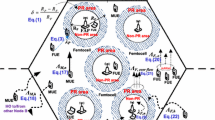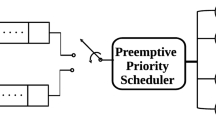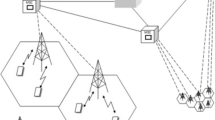Abstract
This paper proposes an admission control algorithm for cellular networks based on the direct and dynamic monitoring of quality of services (QoS) performance metrics—both system delay tail and residual throughput. The main purpose of directly monitoring these QoS performance metrics is to more precisely meet the QoS requirements. The delay tail is efficiently estimated by the proposed algorithm and the total residual throughput is determined based on the total achieved throughput and total required throughput. With the estimated delay tails and measured residual throughput, the admission or rejection of a new user is determined at each base station. By doing so, the admission control algorithm improves resource utilization by guaranteeing the QoS. Additionally, the cellular system becomes more robust against the time-varying fading channel environment. The simulation results of the long term evolution downlink system show that the proposed algorithm can achieve a significant improvement in results compared to those of reference schemes. A general Neyman–Pearson-like framework is also used in evaluating the various admission control mechanisms.










Similar content being viewed by others
References
Kim, Y. K., & Prasad, R. (2005). 4G: roadmaps and emerging communication technologies. London: Artech House.
3GPP Std TS 36.300 v8.9.0. (2009). Evolved universal terrestrial radio access (EUTRA) and evolved universal terrestrial radio access network (EUTRAN); overall description.
IEEE Std 802.16m-08/033r4. (2008). The Draft IEEE 802.16m system description document.
Ramjee, R., Nagarajan, R., & Towesley, D. (1997). On optimal call admission control in cellular networks. Wireless Networks, 3(1), 29–41.
Hou, J., & Fang, Y. (2001). Mobility-based call admission control schemes for wireless mobile networks. Wireless Communications and Mobile Computing, 1(3), 269–282.
Casoni, M., Immovilli, G., & Merani, M. (2002). Admission control in T/CDMA systems supporting voice and data applications. IEEE Transactions on Wireless Communications, 1(3), 540–548.
Oh, E., Han, S., & Woo, C. (2008). Call admission control strategy for system throughput maximization considering both call- and packet-level QoSs. IEEE Transactions on Communications, 56(10), 1591–1596.
Hou, I., & Kumar, P. R. (2009). Admission control and scheduling for QoS guarantees for variable-bit-rate applications on wireless channels categories and subject descriptors. In Proceedings of the 10th ACM Mobihoc.
Hamdaoui, B., Elaoud, M., & Ramanathan, P. (2009). A delay-based admission control mechanism for multimedia support in IEEE 802.11e wireless LANs. Wireless Networks, 15(7), 875–886.
Bae, Y., Park, J., & Choi, B. (2010). Admission control scheme for voice calls guaranteeing both packet-level QoS and call-level QoS in IEEE 802.16e. In IEEE VTC 2010-Fall.
Poor, H. V. (1994). An introduction to signal detection and estimation (2nd edn). New York: Springer.
Song, G., Li, Y., Cimini, L., & Zheng, H. (2004). Joint channel-aware and queue-aware data scheduling in multiple shared wireless channels. In Proceedings of IEEE WCNC 2004.
Attar, R., & Esteves, E. (2002). A reverse link outer-loop power control algorithm for cdma2000 1xEV systems. In Proceedings of IEEE ICC 2002.
3GPP Std TS.211 v8.9.0. (2008). Evolved universal terrestrial radio access (EUTRA); Physical Channels and Modulation.
ITU-R Report M.2135. (2009). Guidelines for evaluation of radio interface technologies for IMT-Advanced.
3GPP Std R1-070674. (2007). LTE physical layer framework for performance verification.
Acknowledgments
This research was supported by the MKE (The Ministry of Knowledge Economy), Korea, under the ITRC (Information Technology Research Center) support program supervised by the NIPA (National IT Industry Promotion Agency (NIPA-2012-(H0301-12-2003)).
Author information
Authors and Affiliations
Corresponding author
Rights and permissions
About this article
Cite this article
Kim, DH., Zhang, D., Bhushan, N. et al. Admission control for cellular networks with direct QoS monitoring. Wireless Netw 19, 131–144 (2013). https://doi.org/10.1007/s11276-012-0455-y
Published:
Issue Date:
DOI: https://doi.org/10.1007/s11276-012-0455-y




